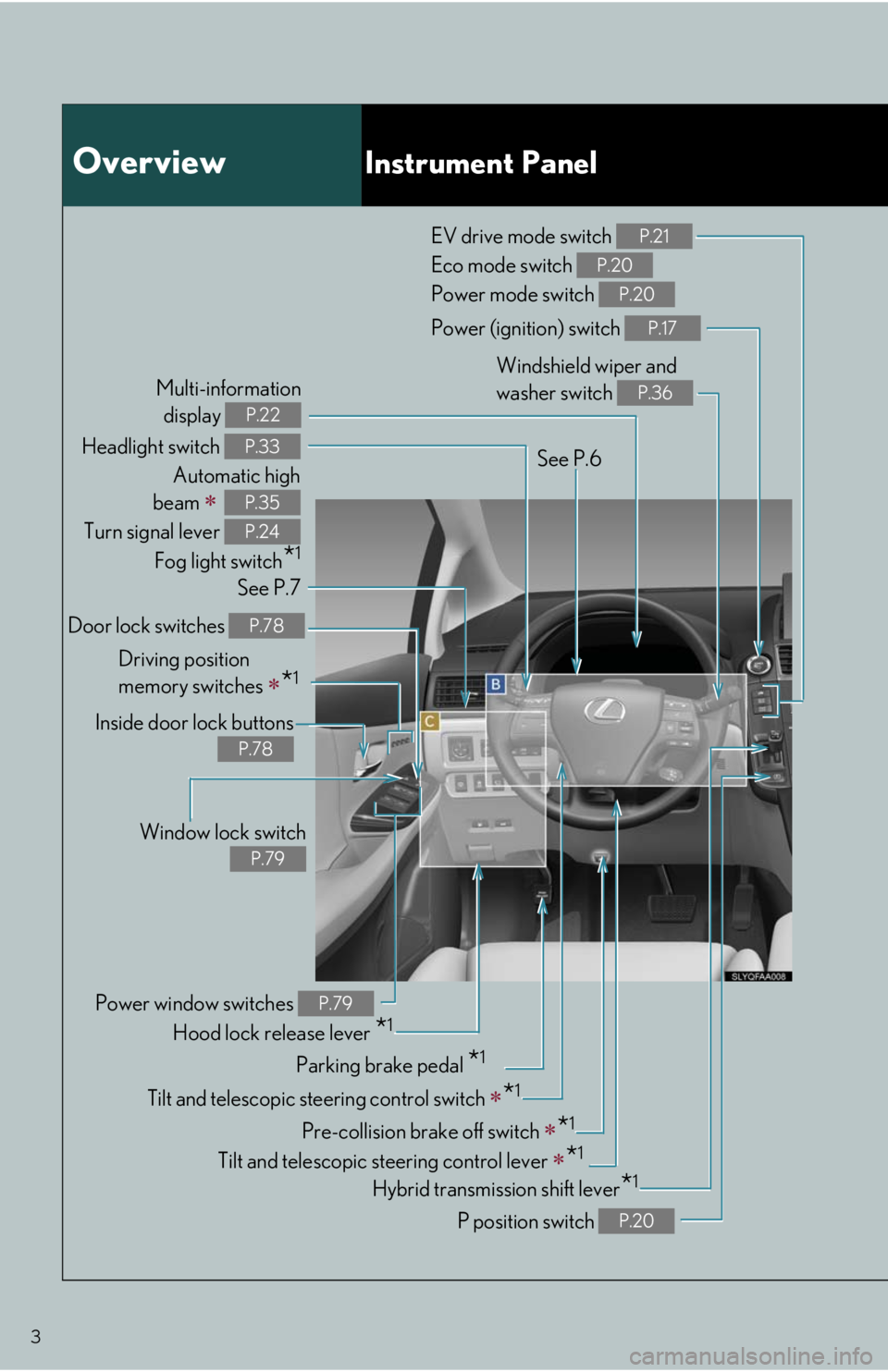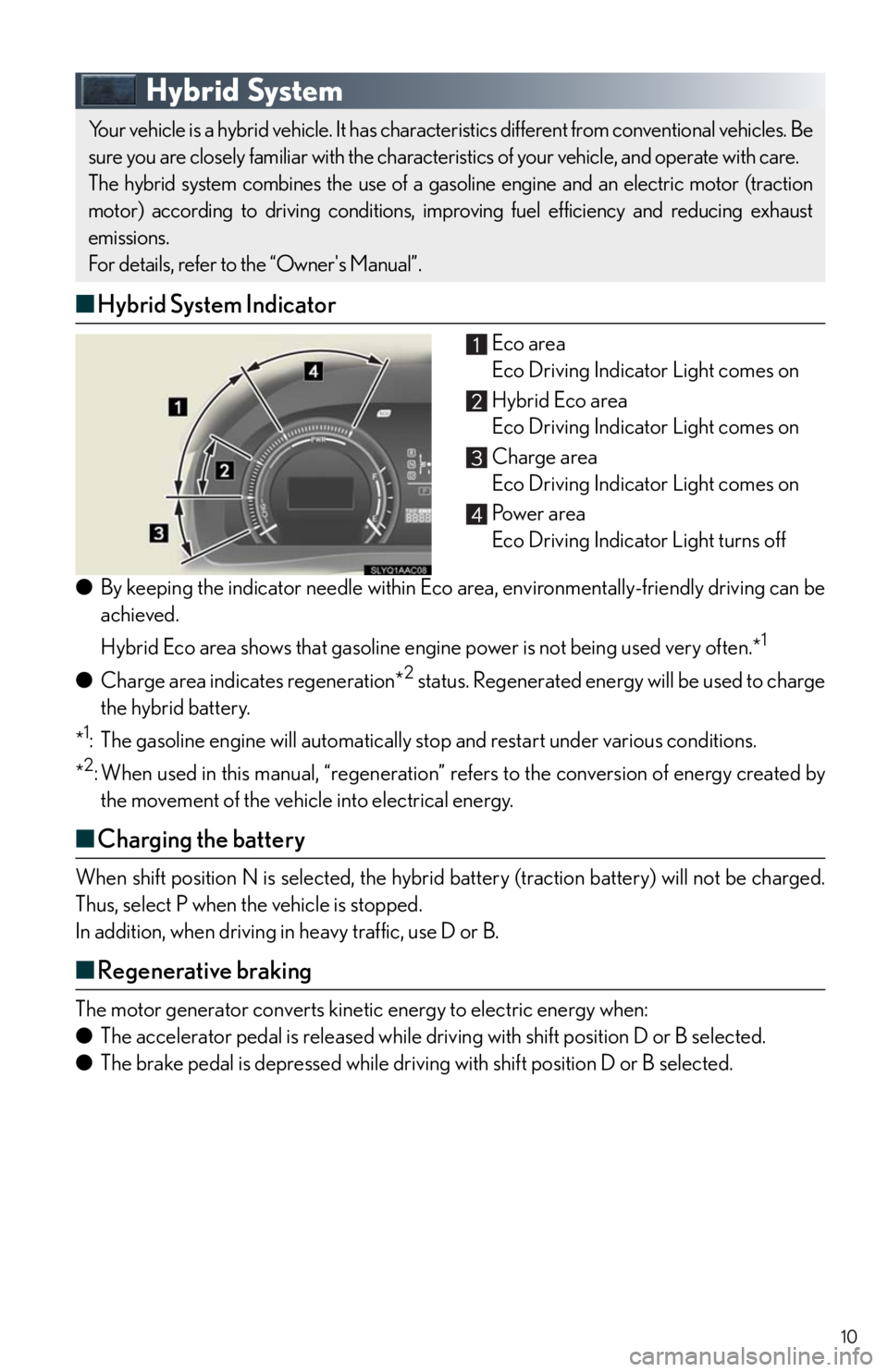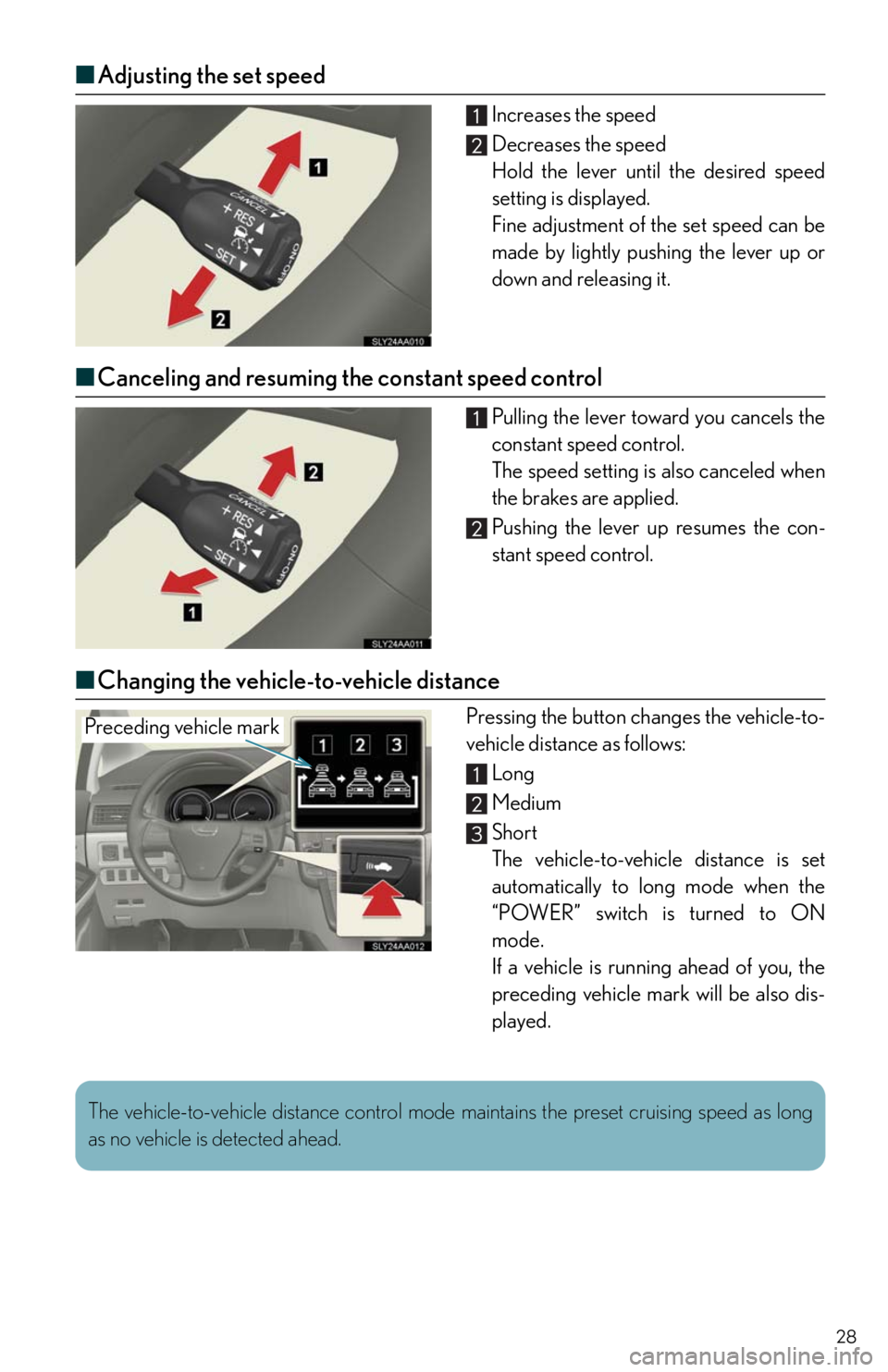brake Lexus HS250h 2010 Using the Bluetooth audio system / LEXUS 2010 HS250H QUICK GUIDE OWNERS MANUAL (OM75023U)
[x] Cancel search | Manufacturer: LEXUS, Model Year: 2010, Model line: HS250h, Model: Lexus HS250h 2010Pages: 86, PDF Size: 5.16 MB
Page 3 of 86

3
OverviewInstrument Panel
Headlight switch
Automatic high
beam
Turn signal lever
Fog light switch
*1
P.33
P.35
P.24
Power (ignition) switch P.17
See P.6
See P.7Windshield wiper and
washer switch
P.36
EV drive mode switch
Eco mode switch
Power mode switch P.21
P.20
P.20
Hybrid transmission shift lever*1
P position switch P.20
Tilt and telescopic steering control switch *1
Pre-collision brake off switch *1
Tilt and telescopic steering control lever *1
Parking brake pedal *1
Hood lock release lever *1 Door lock switches
P.78
Power window switches P.79
Window lock switch
P.79
Inside door lock buttons
P.78
Driving position
memory switches
*1
Multi-information
display
P.22
Page 10 of 86

10
Hybrid System
■Hybrid System Indicator
Eco area
Eco Driving Indicator Light comes on
Hybrid Eco area
Eco Driving Indicator Light comes on
Charge area
Eco Driving Indicator Light comes on
Pow e r a r e a
Eco Driving Indicator Light turns off
●By keeping the indicator needle within Eco area, environmentally-friendly driving can be
achieved.
Hybrid Eco area shows that gasoline engine power is not being used very often.*
1
●Charge area indicates regeneration*2 status. Regenerated energy will be used to charge
the hybrid battery.
*
1: The gasoline engine will automatically stop and restart under various conditions.
*
2: When used in this manual, “regeneration” refers to the conversion of energy created by
the movement of the vehicle into electrical energy.
■Charging the battery
When shift position N is selected, the hybrid battery (traction battery) will not be charged.
Thus, select P when the vehicle is stopped.
In addition, when driving in heavy traffic, use D or B.
■Regenerative braking
The motor generator converts kinetic energy to electric energy when:
●The accelerator pedal is released while driving with shift position D or B selected.
●The brake pedal is depressed while driving with shift position D or B selected.
Your vehicle is a hybrid vehicle. It has characteristics different from conventional vehicles. Be
sure you are closely familiar with the characteristics of your vehicle, and operate with care.
The hybrid system combines the use of a gasoline engine and an electric motor (traction
motor) according to driving conditions, improving fuel efficiency and reducing exhaust
emissions.
For details, refer to the “Owner's Manual”.
Page 11 of 86

11
■Sounds and vibrations specific to a hybrid vehicle
There may be no engine sounds or vibration even though the vehicle is able to move. Always
change the shift position to P when parked.
The following sounds or vibrations may occur when the hybrid system is operating and are
not a malfunction:
●Motor sounds may be heard from the engine compartment.
●Sounds may be heard from the hybrid battery (traction battery) behind the rear seats
when the hybrid system starts or stops.
●Sounds from the hybrid system may be heard when the trunk lid is open.
●Sounds may be heard from the transaxle when the hybrid system starts or stops, or while
the vehicle is idling.
●Engine sounds may be heard when accelerating sharply.
●Sounds may be heard due to regenerative braking when the brake pedal is depressed
and accelerator is loosened.
●Other sounds, such as motors and mechanical noises, may be heard from the brake sys-
tem when the brake pedal is depressed.
●Vibration may be felt when the gasoline engine starts or stops.
●Cooling fan sounds may be heard from the air intake vent on the side of rear left seat-
back.
When driving in Eco mode, the fan noise may be louder than when driving normally.
■Running out of fuel
When the vehicle has run out of fuel and the hybrid system cannot be started, refuel the
vehicle with at least enough gasoline to make the low fuel level warning light go off. If there is
only a small amount of fuel, the hybrid system may not be able to start.
(The minimum amount of fuel to add to make the low fuel level warning light go out is more
than 2.6 gal. [10 L, 2.1 Imp.gal.], when the vehicle is on a level surface. This value may vary
when the vehicle is on a slope.)
Energy Monitor / Consumption Screen
■Energy monitor
The energy monitor can be displayed on both the navigation system screen and the multi-
information display.
●How to display on the navigation system screen (P. 3 8 ) :
Press the “MENU” button, and select “Info. Phone” after that select “Fuel consumption”.
If the “Consumption” or “Past Record” screen is displayed, select the “Energy” and press
the “ENTER” button.
●How to display on the multi-information display:
Toggle the “ENTER” switch on the steering wheel upward or downward through several
times to select the energy monitor display.
You can view the status of your hybrid system on the multi-information display and the
navigation system screen.
Page 17 of 86

17
Power (Ignition) Switch
■Starting the hybrid system
Check that the parking brake is set.
Firmly depress the brake pedal.
The “POWER” switch indicator will
turn green. If the indicator does not
turn green, the hybrid system cannot
be started.
When shift position N is selected, the
hybrid system cannot start. Select the
P position when starting the hybrid
system.
Press the “POWER” switch.
After a while, the “READY” indictor
comes on with a beep sound.
The vehicle can move when the
“READY” indicator is on even if the
engine is stopped.
Continue depressing the brake pedal
until the hybrid system is completely
started.
The hybrid system can be started
from any mode.
■Stopping the hybrid system
Stop the vehicle by depressing the brake pedal.
Set the parking brake.
Press the P position switch to shift into P.
Check that the shift position indicator on the instrument cluster shows P.
Press the “POWER” switch.
Slowly release the brake pedal and check that the indicator on the “POWER” switch is
off.
Performing the following operations when carrying the electronic key on your person
starts the hybrid system or changes “POWER” switch modes.
Page 18 of 86

18
■Changing “POWER” switch modes
Modes can be changed by pressing the “POWER” switch with the brake pedal released.
(The mode changes each time the switch is pressed.)
Off
The emergency flashers can be used.
ACCESSORY mode
Some electrical components such as the
audio system can be used.
The “POWER” switch indicator turns
amber.
ON mode
All electrical components can be used.
The “POWER” switch indicator turns
amber.
Page 19 of 86

19
Hybrid transmission
■Shifting the shift lever
Shift lever
Operate the shift lever gently and
ensure correct shifting operation.
When shifting to the D or R
positions, move the shift lever
along the shift gate.
To shift to the N position, slide
the shift lever to the left and hold
it. The shift position will change
to N.
Shifting to B is only possible
when shift position D is selected.
The shift lever will always return
to this position after a shifting
operation.
When shifting from P to D or R, from D
to R, or from R to D, ensure that the
brake pedal is being depressed and the
vehicle is stationary.
Shift position indicator
When selecting the shift position, make
sure that the shift position has been
changed to the desired position by
checking the shift position indicator pro-
vided on the instrument panel.
When any shift position other than D or
B is selected, the arrow toward B disap-
pears from the shift position indicator.
■Shift position purpose
*: For good fuel economy and noise reduction, the D position should usually be used.
Shift positionFunction
PParking the vehicle/starting the hybrid system
RReversing
NNeutral
DNormal driving*
BApplying moderate engine braking when driving down hills or on
steep slopes
Page 20 of 86

20
■P position switch
The shift position can be changed to P through use of the P position switch.
Fully stop the vehicle and keep depressing
the brake pedal, and then press the P posi-
tion switch.
When the shift position is changed to P,
the switch indicator comes on.
Check that the P position indicator is
illuminated on the shift position indicator.
■Selecting a driving mode
The following modes can be selected to suit driving conditions:
Eco mode
Suitable for improving the fuel economy.
Both the vehicle motive force and air
conditioning system operation will be
minimized.
When the Eco mode switch is pressed,
the “ECO MODE” indicator comes on
in the meter.
Pow e r m o d e
Suitable when the vehicle needs to drive
powerfully or travels in mountainous
areas.
When the power mode switch is
pressed, the “PWR MODE” indicator
comes on in the meter.
■Changing the shift position from P to other positions:
• While depressing the brake pedal firmly, operate the shift lever. If the shift lever is oper-
ated without depressing the brake pedal, the buzzer will sound and the shifting opera-
tion will be disabled.
• The shift position cannot be changed from P to B directly.
Page 26 of 86

26
■Adjusting the set speed
Increases the speed
Decreases the speed
Hold the lever until the desired speed
setting is obtained.
Fine adjustment of the set speed can be
made by lightly pushing the lever up or
down and releasing it.
■Canceling and resuming the constant speed control
Pulling the lever toward you cancels the
constant speed control.
The speed setting is also canceled when
the brakes are applied.
Pushing the lever up resumes the con-
stant speed control.
Dynamic Radar Cruise Control (If equipped)
Indicator (vehicle-to-vehicle distance
control mode)
Indicator (SET)
Indicator (constant speed control mode)
Display
Vehicle-to-vehicle distance button
Cruise control switch
Dynamic radar cruise control supplements conventional cruise control with a vehicle-to-
vehicle distance control. In vehicle-to-vehicle distance control mode, the vehicle automat-
ically accelerates or decelerates in order to maintain a set following distance from vehi-
cles ahead.
Page 28 of 86

28
■Adjusting the set speed
Increases the speed
Decreases the speed
Hold the lever until the desired speed
setting is displayed.
Fine adjustment of the set speed can be
made by lightly pushing the lever up or
down and releasing it.
■Canceling and resuming the constant speed control
Pulling the lever toward you cancels the
constant speed control.
The speed setting is also canceled when
the brakes are applied.
Pushing the lever up resumes the con-
stant speed control.
■Changing the vehicle-to-vehicle distance
Pressing the button changes the vehicle-to-
vehicle distance as follows:
Long
Medium
Short
The vehicle-to-vehicle distance is set
automatically to long mode when the
“POWER” switch is turned to ON
mode.
If a vehicle is running ahead of you, the
preceding vehicle mark will be also dis-
played.Preceding vehicle mark
The vehicle-to-vehicle distance control mode maintains the preset cruising speed as long
as no vehicle is detected ahead.
Page 81 of 86

What to do if...
81
List of Warning/Indicator Lights
Stop the vehicle immediately. Continuing to drive the vehicle may be dangerous.
(U.S.A.)Brake system warning light
(red indicator)
(Canada)
Stop the vehicle immediately.
Charging system warning light
High engine coolant temperature warning light (flashes or comes on)
Have the vehicle inspected immediately.
Brake system warning light
(yellow indicator)
(Flashing)
“AFS OFF” indicator light
(if equipped)
(U.S.A.)
Malfunction
indicator lamp(comes on)
Slip indicator light
(Canada)
(Flashing)
“LKA” indicator light
(if equipped)
SRS warning light
(Flashing)
Cruise control indicator light
(U.S.A.)
“ABS” warning light(Flashing)
Radar cruise control indica-
tor light (if equipped)
(Canada)
(Flashing and
then continu-
ously on)Tire pressure warning lightElectric power steering
system warning light
(Flashing)
“PCS” warning light
(if equipped)
For further information, refer to the Owner's Manual.